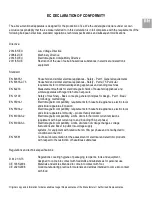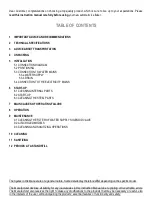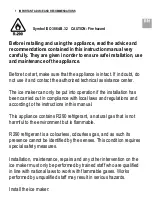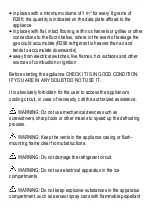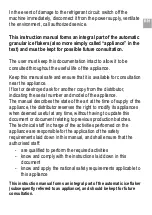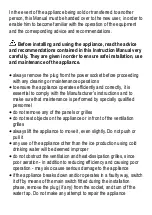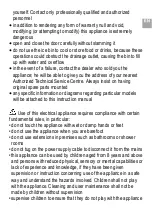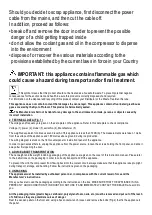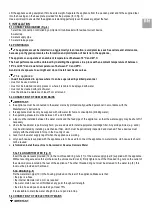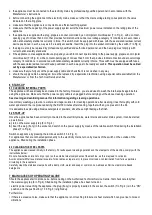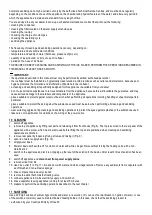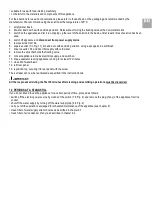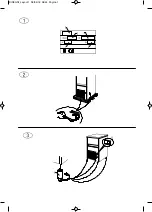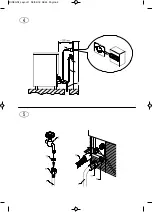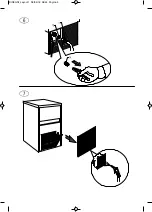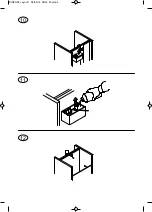
•
the appliance must be connected to the electricity mains by professionally qualified personnel in accordance with the
Manufacturer’s instructions
•
before connecting the appliance to the electricity mains, make sure that the mains voltage rating corresponds to the value
indicated on the rating plate
•
make sure that the appliance is connected to an efficient earthing system
•
make sure that the capacity of the power supply system suits the maximum power value indicated on the rating plate of the
appliance
•
the appliance is supplied with a plug, prepare a socket controlled by an omnipolar circuit-breaker (7 in Fig. 4), with a contact-
opening gap of not less than 3 mm, that provides full disconnection under overvoltage category III conditions, sin accordance
with national safety standards currently in force. This switch must be equipped with fuses, with the associated residual current
device positioned in such a way as to be readily accessible. Insert the plug into the socket controlled by the switch (7 in Fig. 4)
•
the plug must only be replaced by professionally qualified and authorized personnel, and the new plug must comply with
current national safety standards
•
if the appliance comes supplied without a plug and you wish to connect it permanently to the power supply, prepare an omnipolar
circuit-breaker (7 in Fig. 4), with a contact-opening gap of not less than 3 mm, that provides full disconnection under overvoltage
category III conditions, in accordance with national safety standards currently in force. This switch must be equipped with fuses,
with the associated residual current device positioned in such a way as to be readily accessible.
This operation must be carried
out by a specialized technician
•
make sure that you fully uncoil the power supply cable and check that it is not crushed in any way
•
should the supply cable be damaged, it must be replaced by a specialized technician using a special cable available from the
Manufacturer or from the Technical Service Centres
6 START-UP
6.1 CLEANING INTERNAL PARTS
The appliance will have already been cleaned in the factory. However, you are advised to wash the internal parts again before
using the appliance. Make sure that the power supply cable is unplugged before carrying out the above cleaning operation.
See cleaning and sanitizing manual for information regarding cleaning operations.
Use ordinary washing-up liquid or a water and vinegar solution for cleaning operations; after cleaning, rinse thoroughly with cold
water and discard the ice produced during the first 30 minutes after cleaning, together with any ice present in the bin.
It is advisable to avoid using abrasive detergents or powders, since these might damage the finish.
6.2 START-UP
Once the appliance has been correctly connected to the electricity mains, water mains and water drain system, it can be started
up as follows:
a)
turn on the water supply tap (8 in Fig. 4)
b)
insert the plug (if any) in the socket and switch on the power supply by means of the relative switch fitted during the installation
phase (7 in Fig. 4)
Switch on appliance by pressing the luminous switch (13 in Fig. 3).
For appliances that are connected permanently to the electricity mains, turn on by means of the switch on the outside of the
appliance, fitted during the installation phase.
6.3 CLEANING THE STEEL PARTS
The appliance was cleaned initially in the factory. For subsequent cleaning operations on the steel parts of the machine, comply with the
instructions below:
Do not allow saline solutions to dry or pool on the external steel components of the machine, as this may lead to corrosion.
Avoid contact with ferrous material (scourers, forks, ladles, scrapers, etc.) to prevent corrosion, contamination from ferrous particles
circulating in the receptacle.
Carefully clean the stainless steel parts with a damp cloth, water and soap or common, non-abrasive chlorine or ammonia based
detergents.
7 MAIN CAUSES OF OPERATING FAILURE
Should the appliance fail to produce ice, before calling on the Authorized Technical Service Centre, first check carefully that:
• the water supply tap (8 in Fig. 4), fitted during the installation phase, has been turned on
• electric power is reaching the appliance; the plug (if any) is properly inserted in the socket, the switch (7 in Fig. 4) is in the “ON”
position, and the push button (13 in Fig. 3) is lighted up
Furthermore:
• if there is excessive noise, make sure that the appliance is not touching furniture or sheet metal which can give rise to noise or
vibrations
Summary of Contents for ICE115AS-R2
Page 1: ...Mod ICE115AS R2 Production code GB903A HC 08 2018 ...
Page 15: ...DISEGNI_Layout 1 06 04 18 08 44 Pagina 1 ...
Page 16: ...DISEGNI_Layout 1 06 04 18 08 44 Pagina 2 ...
Page 17: ...DISEGNI_Layout 1 06 04 18 08 44 Pagina 3 ...
Page 18: ...8 9 DISEGNI_Layout 1 06 04 18 08 44 Pagina 4 ...
Page 19: ...10 11 12 DISEGNI_Layout 1 06 04 18 08 44 Pagina 5 ...


